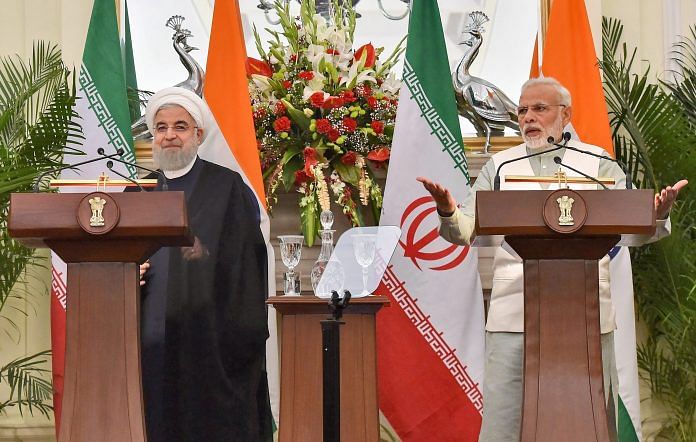That Iran has stuck to the long-promised collaboration with India is testimony to its desire to steer clear of power games played by both China and the US.
The just-concluded visit of Iranian President Hassan Rouhani to India is a counter to the covert Chinese pressure on Iran to scuttle chances of India’s use of the Chabahar port for trade and transit.
Apparently, the Chinese see Chabahar as a counterpoise to their efforts to establish maritime supremacy in the region in conjunction with Pakistan, which they regard as virtually a vassal state.
That Iran has stuck to the long-promised collaboration with India is testimony to its desire to steer clear of power games played by both China and, for different reasons, by the US, which flexes its muscles from time to time on the nuclear non-proliferation tangle.
India’s strategic thrust with Iran is despite US and Israeli pressure calling Iran a rogue nuclear state. Even though the US officially said there is no contradiction between US-Iran sanctions and India’s port project in Chabahar.
That Prime Minister Narendra Modi first hosted Israeli Prime Minister Benjamin Netanyahu in New Delhi with demonstrable warmth, and then went to visit Israel’s bête noire Palestine and followed that up with hosting Rouhani — is a measure of the dare-devilry streak in his foreign policy. How efficacious that would prove remains to be seen. But it is a rare
assertion of Indian sovereignty and of this country’s evidently strong self-confidence.
While China is encircling India with neighbours that it has befriended with maritime supremacy in mind, an Indian counter-move was sorely needed to reinforce India’s muscle power. That leverage it is seeking to achieve with operational control of part of the Iranian east coast port of Chabahar for 18 months with prospect of extension.
The Chabahar port is, apart from being used to ferry goods and services to far-off lands from India, expected to give Afghanistan a much-needed outlet to the sea, skirting Pakistan. For landlocked Afghanistan, Chabahar will come as a big boon. At the same time, it will afford India’s access to energy-rich Central Asian Republics and Russia. The $85 million project is just 90 km from the China-sponsored Gwadar port in Pakistan.
Strategically, it is part of a game of one-upmanship by New Delhi in the region to counter Chinese attempts at establishing hegemony. But the Iranians have their own plans for Afghanistan, looking towards Russia and China for exercising control. The Indian antipathy towards China does not quite fit into the Iranian scheme of things. The challenge for India lies in weaning the Iranians away by appealing to their self-interest.
Japan, Australia and the US know only too well the consequences of China establishing hegemony in the seas and will, hopefully, strive to deny Beijing the strategic advantage in conjunction with India.
While Chabahar was the kingpin in Indo-Iran talks, Iran’s expression of willingness to share its vast oil and natural gas resources with India is promising for the period of higher energy consumption ahead.
But there is a catch that is not comforting for India — Iran is not averse to a Chinese stake in Chabahar if there is a funds-crunch. India wants to ward off that scenario at all costs.
With Iran facing the heat from the US, Iran is looking towards India as a future economic partner. When Iran was globally isolated as a fallout of the sanctions over its nuclear programme between 2012 and 2016, India had continued to buy Iranian oil. After the sanctions were eased, Iran has emerged as the third largest supplier of crude oil to India after Iraq and Saudi Arabia.
Under Modi, Rouhani perceives a more assertive India and one that is not afraid to improvise and experiment as his stance towards Israel on one hand and UAE and Iran on the other has shown.
With Iran unlikely to give in on its nuclear programme to US pressure, Teheran is looking to India for help and continuity in trade.
Rouhani and Modi also have their eyes set on the pending negotiations on the Farzad-B gas and oil fields in Iran’s southern area which India is keen on clinching for its oilfield developers. During Modi’s visit to Iran in 2016, India had hoped to sign an agreement but not much progress was actually made, with Indian officials averring that Iran had been “shifting goalposts” on the bid for Farzad-B. It was India’s Oil and Natural Gas Corporation Limited that had prospected and found oil there. But much to India’s chagrin, Russia’s Gazprom concluded deals for harnessing several oilfields by offering better terms.
India will have to bargain hard to get a slice of the Iranian cake in oil prospecting and developing. Whether there was any headway in New Delhi between the two sides is yet to come out.
There is also scope for strengthening cooperation in connectivity, IT, education, culture and in stepping up people-to-people contacts. Indian technical manpower can help a great deal in building new projects in their formative stage.
Modi has indeed set out on an ambitious journey with Iran as also with West Asia in general. Effective follow-up, quality of work and hard bargaining would be the key to India’s success in a world that is fiercely competitive.
The writer is a senior journalist.






